Marketing Research Report
Write a research report in response to a research brief, using provided data, to answer research questions and provide strategic recommendations for a marketing problem.
23 Pages3265 Words97 Views
Added on 2023-03-31
About This Document
This report presents the findings of a marketing research conducted by Ladder Art Space Company to increase the number of students taking their classes. It includes research objectives, questions, and recommendations based on the findings.
Marketing Research Report
Write a research report in response to a research brief, using provided data, to answer research questions and provide strategic recommendations for a marketing problem.
Added on 2023-03-31
ShareRelated Documents
1
MARKETING RESEARCH
Name of Student:
Name of Institution;
Date:
MARKETING RESEARCH
Name of Student:
Name of Institution;
Date:
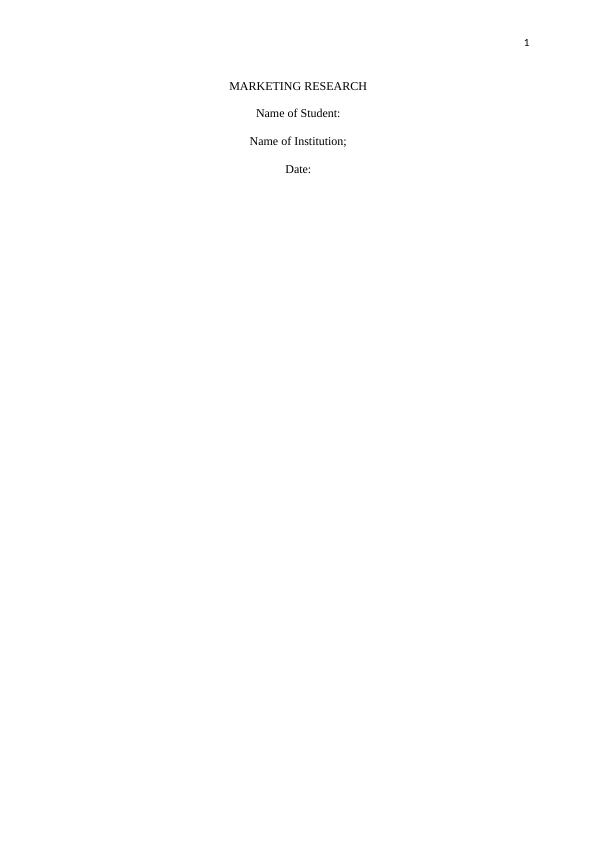
2
Executive Summary
This is a report on research carried out by Ladder Art Space Company. The main objective of
the research was to identify ways in which the organization can increase the number of students
taking their classes. More emphasis was on male students. The main research problem was to
investigate the attitude and awareness levels of university students towards arts events. The
research also sought to identify the most preferred type of art class by this group of students.
There were three (3) research objectives of the study with different research questions. The
research objectives, research questions and the recommendations based the findings are
discussed below.
To begin with, the research question sought to investigate the attendance of art by university
students in Melbourne. The results demonstrated that the majority of university students do not
often attend art classes. The frequency of those who least often attend art classes is 42
representing 28% (the majority).
The other research question was to investigate the difference in the rate of attendance of by
gender. The difference was investigated by cross tabulations. The crosstab demonstrated that
there were a total of 150 university students. Out of the 150 students, 57 of them were identified
to be male students while the remaining 93 were female students. From the results, it is clear
that the majority of students who do not often attend art class are males (25). There are more
males who do not often attend art classes (25) than female students (17).
The other research question investigated the relationship between age and rate of attendance.
The relationship was investigated using the correlation analysis. This is a statistical technique
that is used to investigate the nature and strength of the relationship that exists between two or
more variables. The result of the analysis is recorded in the table below. From the table, the
results indicate that the correlation coefficient between the attendance rate and the age of the
participants is 0.782. This is a strong positive correlation coefficient. It implies that if the age of
Executive Summary
This is a report on research carried out by Ladder Art Space Company. The main objective of
the research was to identify ways in which the organization can increase the number of students
taking their classes. More emphasis was on male students. The main research problem was to
investigate the attitude and awareness levels of university students towards arts events. The
research also sought to identify the most preferred type of art class by this group of students.
There were three (3) research objectives of the study with different research questions. The
research objectives, research questions and the recommendations based the findings are
discussed below.
To begin with, the research question sought to investigate the attendance of art by university
students in Melbourne. The results demonstrated that the majority of university students do not
often attend art classes. The frequency of those who least often attend art classes is 42
representing 28% (the majority).
The other research question was to investigate the difference in the rate of attendance of by
gender. The difference was investigated by cross tabulations. The crosstab demonstrated that
there were a total of 150 university students. Out of the 150 students, 57 of them were identified
to be male students while the remaining 93 were female students. From the results, it is clear
that the majority of students who do not often attend art class are males (25). There are more
males who do not often attend art classes (25) than female students (17).
The other research question investigated the relationship between age and rate of attendance.
The relationship was investigated using the correlation analysis. This is a statistical technique
that is used to investigate the nature and strength of the relationship that exists between two or
more variables. The result of the analysis is recorded in the table below. From the table, the
results indicate that the correlation coefficient between the attendance rate and the age of the
participants is 0.782. This is a strong positive correlation coefficient. It implies that if the age of
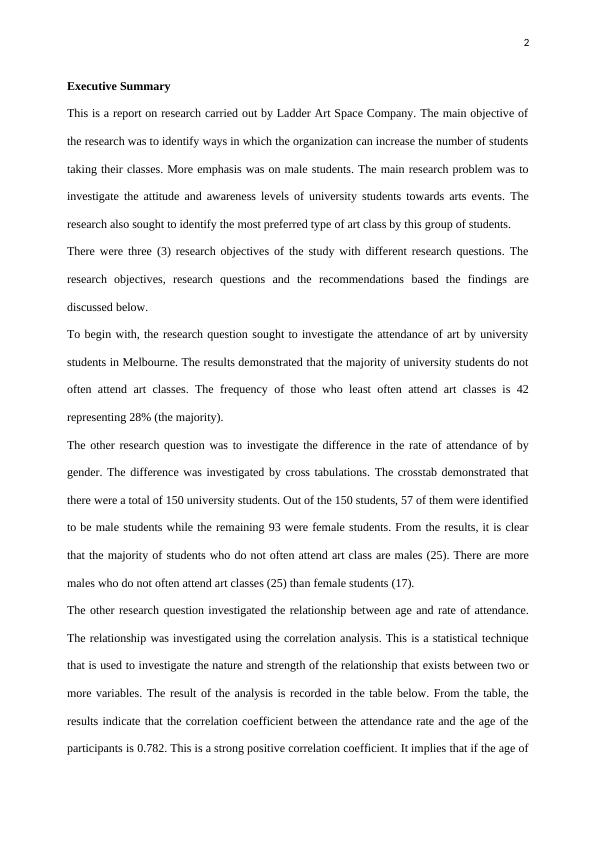
3
a student is increased by 1 unit, this will cause a corresponding increase in the rate of
attendance by 0.782 units and vice versa. This relationship is therefore significant since the
significance value (0.023) is less than the standard level of significance (0.05).
To investigate the attitude of the students and their awareness levels towards different types of
art classes, the frequency table of attitude towards art classes was obtained. From the results,
most of the students (10%) rate their attitudes at 4.5 on a scale of 1 to 7.
The difference in interest in life drawing classes based on the exposure levels was investigated
using the ANOVA test. The results obtained indicated that the significant value is less than the
standard level of significance (0.05). Statistically speaking, the evidence is sufficient to
conclude that there was a difference in interest in life drawing classes by the level of exposure.
How the gender of the participant was related to the most preferred type of classes was
investigated using the Analysis of variance (ANOVA) test. ANOVA test investigates whether
there exists any significant difference in the mean values of the difference. The findings are
recorded in a table shown below. These results clearly show that the significance value is 0.163,
a value which is less than the significance value. In conclusion, it is statistically correct to
conclude that these variables have no significant difference in their means.
a student is increased by 1 unit, this will cause a corresponding increase in the rate of
attendance by 0.782 units and vice versa. This relationship is therefore significant since the
significance value (0.023) is less than the standard level of significance (0.05).
To investigate the attitude of the students and their awareness levels towards different types of
art classes, the frequency table of attitude towards art classes was obtained. From the results,
most of the students (10%) rate their attitudes at 4.5 on a scale of 1 to 7.
The difference in interest in life drawing classes based on the exposure levels was investigated
using the ANOVA test. The results obtained indicated that the significant value is less than the
standard level of significance (0.05). Statistically speaking, the evidence is sufficient to
conclude that there was a difference in interest in life drawing classes by the level of exposure.
How the gender of the participant was related to the most preferred type of classes was
investigated using the Analysis of variance (ANOVA) test. ANOVA test investigates whether
there exists any significant difference in the mean values of the difference. The findings are
recorded in a table shown below. These results clearly show that the significance value is 0.163,
a value which is less than the significance value. In conclusion, it is statistically correct to
conclude that these variables have no significant difference in their means.
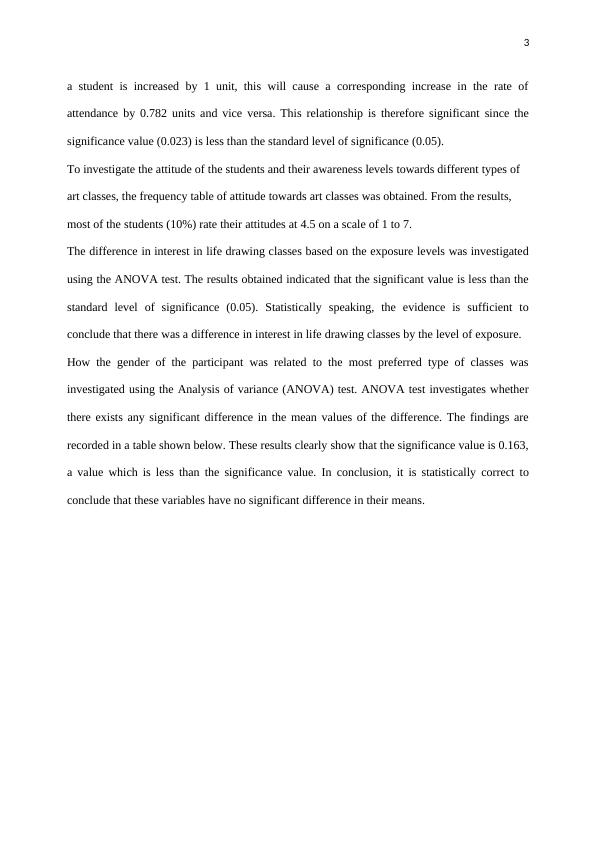
4
Contents
Methodology.............................................................................................................................................5
Results.......................................................................................................................................................5
Conclusion and Recommendations..........................................................................................................12
References...............................................................................................................................................13
Appendix: relevant output from statistical analysis software packages...................................................14
-
Contents
Methodology.............................................................................................................................................5
Results.......................................................................................................................................................5
Conclusion and Recommendations..........................................................................................................12
References...............................................................................................................................................13
Appendix: relevant output from statistical analysis software packages...................................................14
-

5
Methodology
The research question was aimed at investigating the attendance patterns of arts events by
university students in the city of Melbourne. The results demonstrated that the majority of
university students do not often attend art classes. The other research question was to
investigate the difference in the rate of attendance of by gender. The difference was investigated
by cross tabulations. Also, the research investigated how the age of participants was related to
their rate of attendance. This relationship was investigated by evaluating the correlation
analysis.
The attitude of the participants towards events and their levels of interest towards different
types of art classes was investigated by obtaining the frequency table of attitude towards art
classes overall. The difference in interest in life drawing classes by the level of exposure was
investigated using the ANOVA test. An Analysis of variance (ANOVA) test was carried out to
investigate how gender and the most preferred type of classes were related.
Results
Research Objective 1: To investigate the attendance rate arts events in Melbourne among
university students
RQ1: How many university students in Melbourne attend arts events within a given
period, say one day?
The rate of attendance of arts events among university students in Melbourne was established
by conducting a frequency test. The frequency table below demonstrates that only a minority of
university students often attend art classes. The frequency of those who least often attend art
classes is 42 representing 28% (the majority) (Iskandar, et al., 2014).
Methodology
The research question was aimed at investigating the attendance patterns of arts events by
university students in the city of Melbourne. The results demonstrated that the majority of
university students do not often attend art classes. The other research question was to
investigate the difference in the rate of attendance of by gender. The difference was investigated
by cross tabulations. Also, the research investigated how the age of participants was related to
their rate of attendance. This relationship was investigated by evaluating the correlation
analysis.
The attitude of the participants towards events and their levels of interest towards different
types of art classes was investigated by obtaining the frequency table of attitude towards art
classes overall. The difference in interest in life drawing classes by the level of exposure was
investigated using the ANOVA test. An Analysis of variance (ANOVA) test was carried out to
investigate how gender and the most preferred type of classes were related.
Results
Research Objective 1: To investigate the attendance rate arts events in Melbourne among
university students
RQ1: How many university students in Melbourne attend arts events within a given
period, say one day?
The rate of attendance of arts events among university students in Melbourne was established
by conducting a frequency test. The frequency table below demonstrates that only a minority of
university students often attend art classes. The frequency of those who least often attend art
classes is 42 representing 28% (the majority) (Iskandar, et al., 2014).
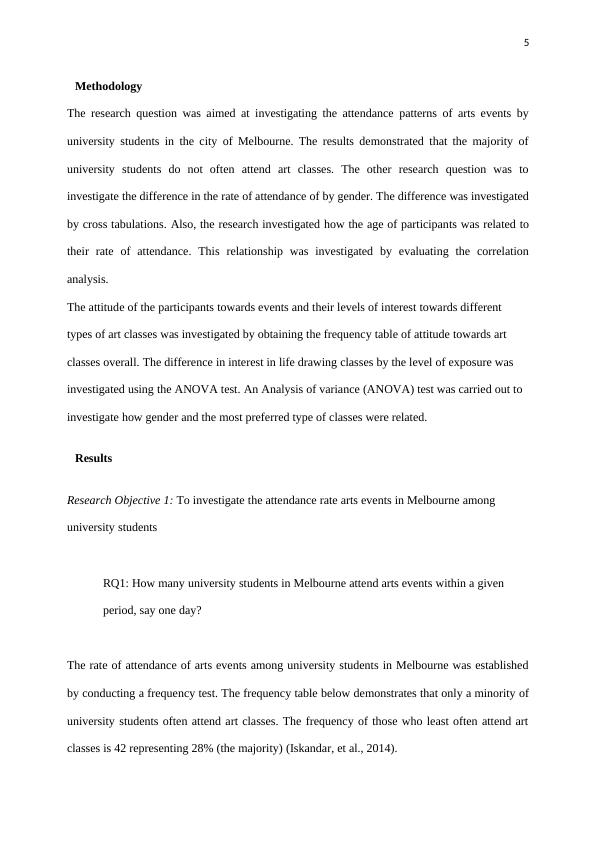
6
Interpretation: Majority of university students in Melbourne do not often attend art events. We
could say that the students are mostly engaged with other activities that prevent them from
taking part in art activities. Similarly, we can say that probably university students in
Melbourne view art activities as less important in their lives or in their studies. Another possible
contributing factors could be that probably, there is less sensitization among the students about
the benefits of such activities among the students. Therefore, the attendance of art activities can
be improved by proper sensitization of the students about the importance of art and art activities
to their lives and their studies.
How often in average do you attend to a museum, galleries, arts and culture event and
festivals each year?
Frequency Percent Valid Percent Cumulative
Percent
Valid 1 42 28.0 28.0 28.0
2 34 22.7 22.7 50.7
3 11 7.3 7.3 58.0
4 12 8.0 8.0 66.0
5 9 6.0 6.0 72.0
6 2 1.3 1.3 73.3
7 4 2.7 2.7 76.0
8 3 2.0 2.0 78.0
9 2 1.3 1.3 79.3
10 17 11.3 11.3 90.7
12 2 1.3 1.3 92.0
15 6 4.0 4.0 96.0
20 3 2.0 2.0 98.0
21 3 2.0 2.0 100.0
Total 150 100.0 100.0
Interpretation: Majority of university students in Melbourne do not often attend art events. We
could say that the students are mostly engaged with other activities that prevent them from
taking part in art activities. Similarly, we can say that probably university students in
Melbourne view art activities as less important in their lives or in their studies. Another possible
contributing factors could be that probably, there is less sensitization among the students about
the benefits of such activities among the students. Therefore, the attendance of art activities can
be improved by proper sensitization of the students about the importance of art and art activities
to their lives and their studies.
How often in average do you attend to a museum, galleries, arts and culture event and
festivals each year?
Frequency Percent Valid Percent Cumulative
Percent
Valid 1 42 28.0 28.0 28.0
2 34 22.7 22.7 50.7
3 11 7.3 7.3 58.0
4 12 8.0 8.0 66.0
5 9 6.0 6.0 72.0
6 2 1.3 1.3 73.3
7 4 2.7 2.7 76.0
8 3 2.0 2.0 78.0
9 2 1.3 1.3 79.3
10 17 11.3 11.3 90.7
12 2 1.3 1.3 92.0
15 6 4.0 4.0 96.0
20 3 2.0 2.0 98.0
21 3 2.0 2.0 100.0
Total 150 100.0 100.0
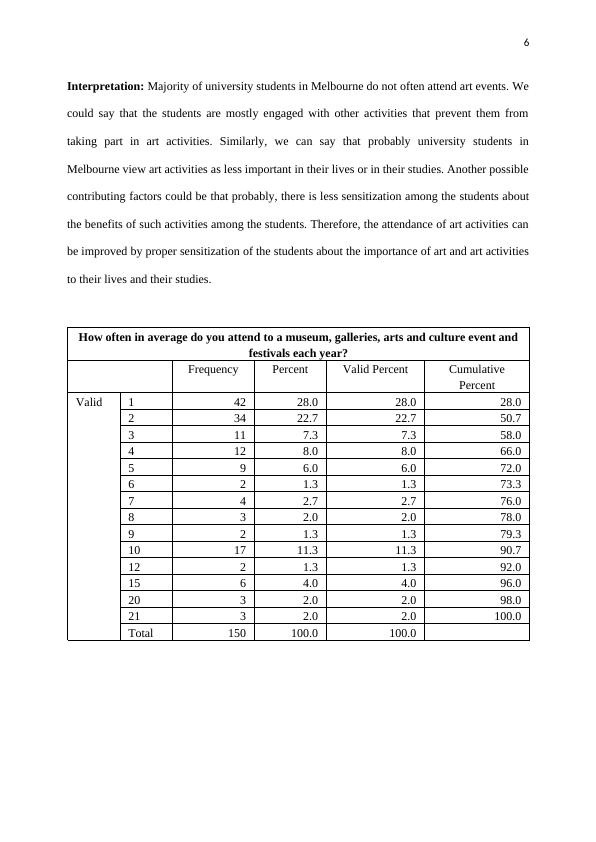
End of preview
Want to access all the pages? Upload your documents or become a member.
Related Documents
Statistics: Confirmatory and Exploratory Analysislg...
|9
|1486
|41
SPSS Statistics Assignmentlg...
|8
|2003
|198
The Basic Practice of Statistics Assignmentlg...
|4
|442
|21
Investigative Methodslg...
|9
|1251
|1
Descriptive Statistics Analysis Assignmentlg...
|4
|640
|24
BSB123 Data Analysislg...
|13
|1715
|331
